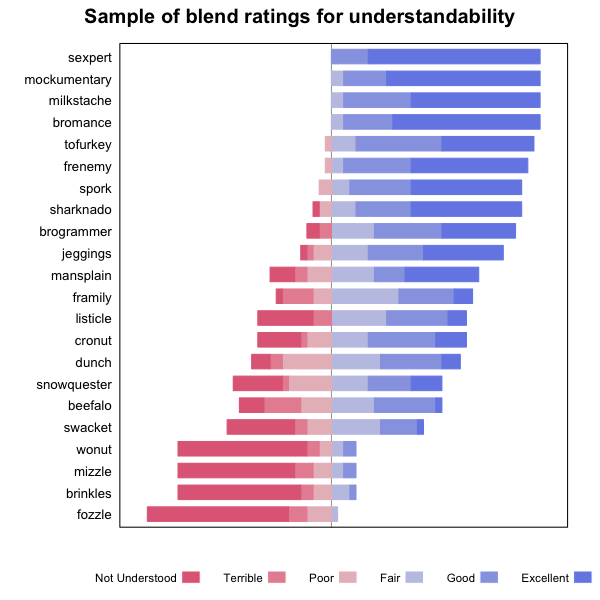Quantifying cronuts: Predicting the quality of blends
Constantine Lignos and Hilary Prichard | Last updated: July 06, 2015
Coverage
Featured in TIME Magazine
This research is featured in the July 2015 TIME Answers issue: Why Did ‘Frenemy’ Stick? Academics are unraveling the mystery behind the success–and failure–of blended words.
Slides
Our first talk on this research was given at the LSA 2015 Annual Meeting in Portland on January 11th, 2015. Slides for our talk can be viewed as a PDF.
Quantifying cronuts
We are all wordsmiths
Being a linguistic innovator is hard. Just ask Gretchen Wieners of Mean Girls:

While it’s hard to make fetch happen, hope for the casual wordsmith comes in the form of the blend. Simply put, word blends (AKA portmanteaux) combine two words to make a new one. Some popular recent innovative blends include mansplain, frenemy, and sext, and there are always the classics like brunch and spork. It’s pretty common to see a novel blend appear in a comedy series:

But not all blends are created equal. Frenemy is a great and instantly-recognizable blend. Framily sounds so bad that in the marketing campaign that introduced it, there was a commercial discussing how you “can’t mush words together like that”:
So, how do we tell good blends from bad ones? We’re conducting a research study at the University of Pennsylvania that tries to explain why some blends are better than others and predict which blends people will like.
Types of blends
Before we move on, we need to define what a blend is. For the purpose of this study we’ll define a blend as follows:
- A combination of two independent words
- Either the sounds of the words overlap (e.g., “ro” in bromance belongs to both words) or parts of the words were deleted to make the blend (e.g., sharknado)
So what isn’t a blend?
- A combination of two words where no sounds were deleted and they don’t overlap (e.g., manspreading)
- Words that use libfixes, or suffixes that may have once been half of a blend but have been “liberated” and can apply to pretty much any word. A good example is -gate (e.g., gamergate).
Blend classes
So now we know what a blend is; let’s define some categories of blends. Before we go further, some quick terminology. Let’s call the two words in the blend source words, and number them 1 and 2, left to right.
- Complete overlap: The sounds of the two words overlap, and all of the sounds in words 1 and 2 are included. These are usually the best-sounding blends. Examples: alcoholiday, bromance, guesstimate, mathlete, palimony, warphan
- Partial overlap: The sounds of the two words overlap, but not all of the sounds are preserved, some are deleted. Examples: affluenza, brony, facon, sext, shitticism
- No overlap: There’s no overlap between the two words, and some sounds were deleted so they could be put together. Examples: cosplay, fanzine, sharknado, zonkey
Our survey
To understand how people perceive these blends, we put together a survey and asked people to rate 88 blends. We gave them an example of a blend without telling them what words it’s made from and asked them to answer the following questions about it:
- Do you understand what it means? If they said no, they could skip straight to the next word.
- Understandability: Is it easy to understand what words make up this blend?
- Naturalness: Does this combination of words sound natural to you?
We knew in advance that it’s not always easy to decide what the difference between understandability and naturalness is; presumably, difficult to understand blends are also unnatural. We’re most interested in the examples where those measures don’t line up: which blends are easy to understand but unnatural (and vice versa)? We’ll look at the difference between those two measures below. For convenience, when giving average ratings we convert the 5-point Likert scale participants used (Terrible, Poor, Fair, Good, Excellent) to a 1-5 scale. (Note for the quantitatively minded: in the actual modeling we perform, we don’t do this conversion and do not make the interval assumption or any normality assumptions regarding the data.)
The best and worst blends
We had 34 people rate 88 items and we analyzed the results to determine what the best and worst blends are. The five most understandable blends were:
| Blend | Source words | Average rating (1-5) |
|---|---|---|
| mathlete | math athlete | 4.8 |
| sexpert | sex expert | 4.8 |
| guesstimate | guess estimate | 4.8 |
| televangelist | television evangelist | 4.7 |
| mockumentary | mock documentary | 4.7 |
So if someone makes a mockumentary about sexperts who were mathletes, they’ll have struck blend gold! The five least understandable blends were:
| Blend | Source words | Average rating (1-5) |
|---|---|---|
| fozzle | fog drizzle | 1.8 |
| mizzle | mist drizzle | 2.3 |
| brinkles | bed wrinkles | 2.3 |
| wonut | waffle donut | 2.5 |
| wegotism | we egotism | 2.6 |
It’s unsurprising that some of the least understandable blends are also not very common. There’s a confound here that we cannot tease apart: novel linguistic terms are more understandable if you hear them more often. You’re more likely to say them if they’re easy to understand. But if we were to say that people give the most popular blends the highest understandability ratings and call it a day, we’d just be begging the question.
Here’s a visualization of a sample of the best and worst blends below. This type of plot is called a “sliding bar graph” and shows how often each blend got each understandability rating. The items are ordered by their average rating for understandability, best at the top.

We collected ratings for naturalness and understandability for each blend, mostly so we could see which blends were understandable but not natural, and vice versa. Here’s a visualization of each item and how it rates on each scale. Items above the line are perceived as more natural than understandable; items below are more understandable than natural. It’s hosted on plot.ly, which allows for an interactive plot. You can hover over items to see the full info, or zoom in to tease apart the overlapping words.
So, what causes an item to be an outlier here? The blends that people understand but find unnatural are often created for marketing purposes: beerstro, coatigan, croissandwich, etc. Many of the ones that are more natural than understandable are very similar to the second word of the blend: brony, brogrammer, brinkles, etc. So, they seem to be rated as natural because they’re about one sound away from a “real” word.
Predicting human ratings
So how can we predict how highly people rate a blend? There are more details in our talk, but here’s a preview.
Let’s say you had to reconstruct a word with only part of the information. What if you knew just the first sounds of the word, how would you guess the rest of it?
Google has helped you with a similar problem every time you search. Here’s what happens if you just type “linguistics is” in the search box. (PS: You can try “linguists are” for some more entertaining results.)

We believe that people are trying to do a similar kind of autocomplete on the source words of a blend. In the case of perfect overlap, since all of the sounds from the source words appear in the blend, it’s trivial to figure out the source words and the blend is very easy to understand.
But take brinkles (bed wrinkles). How would you get bed just from a b? Likewise, in wonut or cronut, the donut part is obvious, but can you guess waffle from w or croissant from cr?
In our talk, we discussed specific statistical measures that let us estimate how hard it is to reconstruct blends. We can use the ratings we collected to build a statistical model of how people rate blends, something we call a blendometer . Our main finding is this: it’s easy to identify the characteristics of bad blends, but good blends come in all sizes. Bad blends are generally difficult to reconstruct from the sounds present from the first word (e.g., just the w- from wonut). However, some blends that are just as hard to reconstruct still do well. It’s like the challenge of predicting what might go viral; some blends have a certain je ne sais quoi that escapes our model because it’s hard to quantify.
Here’s a visualization of how our model compares with human ratings of how understandable a blend is, comparing the average human rating for an item and the average rating predicted by our model. The trend line is there to give you an idea of how the model sees the world, not the best fit for the data. The items below the line are rated worse by humans than our model predicts, the items above are rated better. (Notes for the quantitatively-minded: the model is a cumulative link mixed-effects regression, so it’s tricky to show you its complete understanding of the data, which includes things like estimating how far apart “good” and “excellent” are from each other. Its predictions minimize loss on the actual Likert scale the participants used, not the 1-5 and 0-1 numerical representations we’re using for convenience.)
It’s on the right track, but it’s clear that it overestimates how some of the worst blends do, like brinkles, wonut, and lupper. One of our interests in future work is investigating why those blends are as terrible as they are. We’re also trying to improve the quality of our model and trying to predict where two words should combine to make a blend. For example, why is it frenemy, not fenemy or friendemy? It’s obvious which one sounds best, and we’re trying to make that as obvious to a computer as it is to any human.

This work is licensed under a Creative Commons Attribution-NonCommercial-NoDerivatives 4.0 International License.